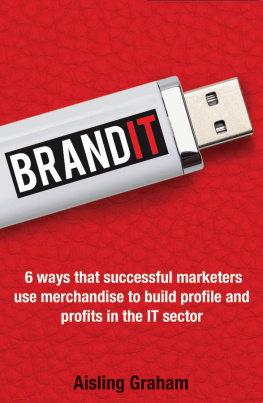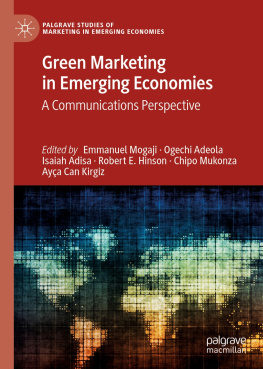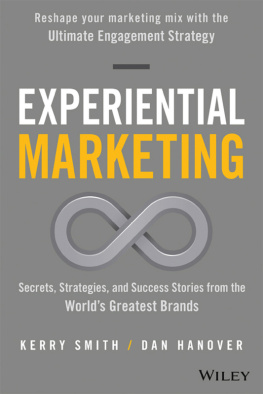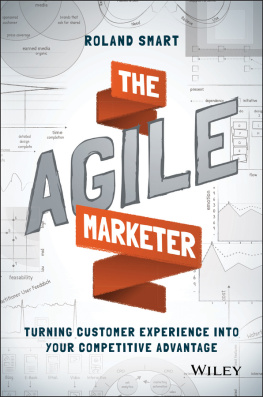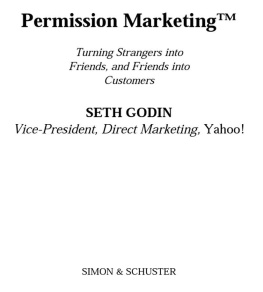EXPERIENTIAL MARKETING
How to Get Customers to
SENSE, FEEL, THINK, ACT, and RELATE
to Your Company and Brands
BERND H. SCHMITT
Co-author of Marketing Aesthetics

THE FREE PRESS
New York

THE FREE PRESS
A Division of Simon & Schuster Inc.
1230 Avenue of the Americas
New York, NY 10020
Copyright 1999 by Bernd H. Schmitt
All rights reserved, including the right of reproduction in whole or in part in any form.
THE FREE PRESS and colophon are trademarks of Simon & Schuster Inc.
Designed by Carla Bolte
Manufactured in the United States of America
20 19 18 17 16 15 14 13 12 11
Library of Congress Cataloging-in-Publication Data
Schmitt, Bernd.
Experiential marketing: how to get customers to sense, feel, think, act, and relate to your company and brands/by Bernd H. Schmitt.
p. cm.
Includes bibliographical references and index.
1. Brand name productsMarketing. 2. Corporate image. I. Title.
HF5415.13.5343 1999
658.827dc21 99-18003
CIP
ISBN 978-0-6848-5423-6
eISBN-13: 978-0-743-21951-8
www.SimonandSchuster.com
To my mother (for SENSE and FEEL)
To my father (for THINK, ACT, and RELATE)
To Hisako (for HOLISTIC)

CONTENTS
PART ONE: THE EXPERIENTIAL MARKETING REVOLUTION

PART TWO: TYPES OF EXPERIENCES

PART THREE: STRUCTURAL, STRATEGIC, AND ORGANIZATIONAL ISSUES

PREFACE
Experiential marketing is everywhere. In a variety of markets and industries (consumer, service, technology, and industrial), a wide variety of I organizations have turned to experiential marketing techniques to develop new products, communicate with customers, improve sales relations, select business partners, design retail environments, and build web sites. This transformation is showing no signs of slowing down. More and more, marketers are moving away from traditional features-and-benefits marketing toward creating experiences for their customers.
This book provides a strategic framework along with implementation tools for this new approach to marketing. I have written about this subject in academic and professional journals and presented the framework at various conferences (in the United States and abroad), ranging from those on brand management and positioning to strategic management and financial services.
One of the core ideas of the experiential marketing approach presented in this book is the creation of different types of experiences for customers. I view these types of experiences as SEMs (Strategic Experiential Modules). Each SEM has its own distinct structures and marketing principles that as a manager you need to be familiar with. As I will show, SEMs include sensory experiences (SENSE); affective experiences (FEEL); creative cognitive experiences (THINK); physical experiences and entire lifestyles (ACT); and social-identity experiences that result from relating to a reference group or culture (RELATE).
Managers create these experiences by using ExPros, or experience providers. These include communications, visual and verbal identity, product presence, co-branding, spatial environments, web sites and electronic media, and people.
The ultimate goal of experiential marketing is to create holistic experiences for customers. As we will see, the creation of SEMs and of holistic experiences raises a range of structural and strategic issues and the key organizational issue of how to build an experience-oriented organization.
This book, and especially chapter 4, builds on my prior book with The Free Press entitled Marketing Aesthetics: The Strategic Management of Brands, Identity, and Image (with Alex Simonson). In Marketing Aesthetics we argued that most of marketing is limiting because of its focus on features and benefits. We then presented a framework for managing sensory experiences. In the present book, I provide a much more detailed exposition of the limitations of the features-and-benefits (F&B) approach of traditional marketing. Moreover, I introduce a new model for managing sensory experiences. Finally, and most important, the book goes beyond sensory experiences by presenting a broad framework for managing all types of experiences, integrating them into holistic experiences, and addressing key structural, strategic, and organizational challenges.
I invite you now to follow me on the path of experiential marketing. If you are in a Proustian state of mind, I suggest you pick up a madeleine in your local grocery store or supermarket for the journey. Before we start, one brief comment about the writing style of the book. In my opinion, most management and marketing literature is too serious and too aggressive. War metaphors of the Beat the competition into the ground type are pervasive, but so is the opposite, the brand is your friend approach, especially in the age of relationship marketing. Few things in business and in life are that cut-and-dried. What I find missing in a lot of management and marketing literature is a sense of humor. Humor stimulates creativity and dialectical thinking, and it can provide a fresh perspective. Humor deflates pretense and opens new avenues of thought. So I have tried to infuse a sense of humor throughout this book.
One part of this humor is LAURA BROWN, whose voice you will encounter at the end of each chapter. Who is LAURA BROWN?
For now, think of LAURA BROWN as a kind of critical, thoughtful voice. Shes the student in the last row who always asks the really hard questions. Shes not impressed with the emperors new clothes. She is Mephisto, the genie in the bottle, but, at the same time, the deus ex machina who saves the day. If you are more technically inclined, think of her as the cookie monster or the Melissa virus that forces you to keep your hard disk clean. The LAURA BROWNs of the world are important. Through their questioning, they keep us honest and focused on what matters. As I mentioned above, you will find LAURA BROWNs questions and commentary at the end of each chapter. And you will find a decisive answer to the question of who she really is in the Epilogue.
ACKNOWLEDGMENTS
As a faculty member in the marketing department at the Graduate IJI School of Business at Columbia University, I am standing on the shoulders of giants. The glorious past and present marketing scholars at Columbia University include, among many others, John Howard, John Farley, Don Lehmann and, last but not least, Morris Holbrook, who already wrote about experiential marketing and hedonic consumption more than twenty-five years ago. The book that I am presenting here is deeply influenced by their path-breaking contributions; in its conceptualization it is decidedly anti-Howardian, in terms of its managerial relevance positively Lehmannian, and in its exposition inspirationally Holbrookian. I trust that John Parley will be pleased to see that it is also truly international, incorporating research and management examples from around the world.


